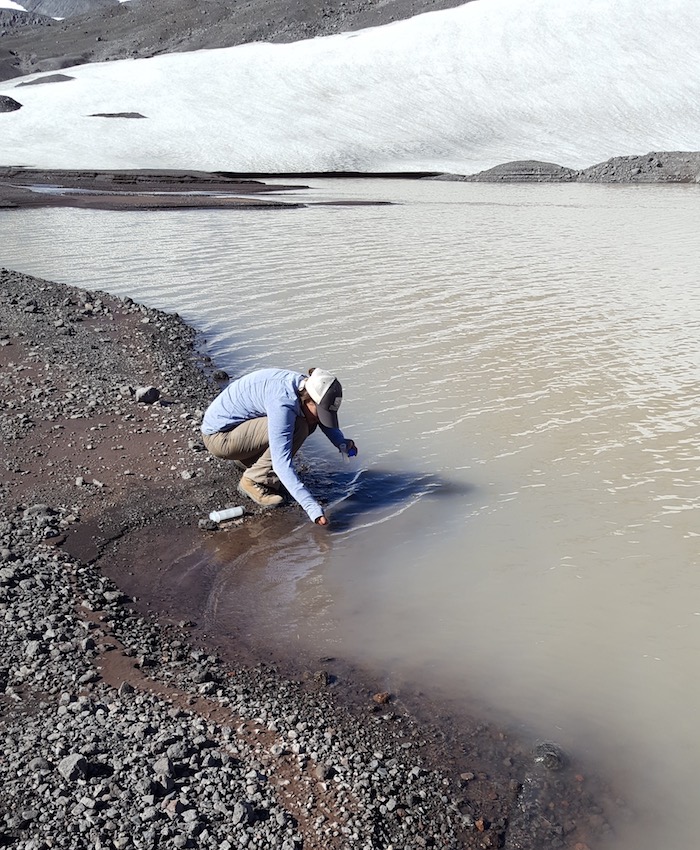Trinity Hamilton wants to unlock the secrets of light-harvesting microbes living in extreme environments in hopes of illuminating where we came from and where we’re going.

Trinity Hamilton collecting samples at Collier Glacier on North Sister in Oregon.
“The more we learn about how microbes affect the environment, the better off we will be.”
Rows of glass beakers half filled with liquid tinted brown and pink and yellow by the anoxygenic microbes that grow within line one shelf of Trinity Hamilton’s lab on the St. Paul campus. At the other end of the counter, another half dozen beakers rotate in an incubator, the bright green hue of the liquid inside a telltale sign that cyanobacteria are present. Dozens of test tubes with dried samples yet to be processed sit nearby. All came from extreme environments where sustaining life is challenging, in this case hotsprings and high elevations. “I love growing things,” says the microbial ecologist. She cultivates this assemblage of microbes in hopes of gaining insights into, among other things, how life evolved on Earth eons ago.
Hamilton is the newest member of the Plant and Microbial Biology faculty at the College of Biological Sciences. She studies a category of microbes known as phototrophs. “Light is their food,” she explains. Like plants, the organisms use photosynthesis to turn light into energy. Hamilton is interested in phototrophs for what they can tell us about the past as well as the future.
Finding her research subjects takes some determination and decent outdoors skills. Hamilton’s upbringing in rural Montana prepared her for the latter. Her childhood was punctuated with camping trips — including long treks on horseback — so forays into the field don’t phase her. She grew up on a stretch of land her family has owned and lived on for generations. “I grew up in the middle of nowhere,” she says. “But then everywhere’s the middle of nowhere in Montana.”
In recent years, she’s spent time camping in and around Yellowstone National Park gathering samples from the area’s famous bubbling cauldrons, which are brimming with microbial life including some anoxygenic cyanobacteria. These microbes live in low-oxygen environments, but may have played a starring role in making the Earth’s atmosphere the oxygen-rich environment on which humans and other creatures depend.
“We may have the phototrophs from hot springs to thank for the very air we breathe,” she says. Earth’s atmosphere was devoid of oxygen until about 2.5 billion years ago. She and others speculate that phototrophs may have set in motion the oxidization that yielded the great oxidation event, when the Earth’s atmosphere first had sustained free oxygen.
Hamilton is equally fascinated by the role of phototrophs in alpine ecosystems. She studies snow algae, which bloom on the surface of glaciers, in the Pacific Northwest’s Cascade Range. As global temperatures rise and snowpack decreases, snow algae may be part of a potentially worrisome feedback loop. The algae lower albedo, which means the ice absorbs more solar energy and melts faster.
“Glaciers serve as large freshwater reserves,” says Hamilton. “Alpine glacial ecosystems like those on stratovolcanoes in the Pacific Northwest, are incredibly important for that reason.” Hamilton notes that there have been multiple glaciations throughout Earth’s history and that rising CO2 correlates with glacial retreat, but that much remains unknown about the dynamics driving the advance and retreat of the ice. “We don’t understand a lot about the tipping points in early Earth’s history,” she says. Understanding that dynamic could prove a useful tool in predicting how quickly glaciers might recede. Hamilton hopes to help fill in that picture.
“The more we learn about how microbes affect the environment, the better off we will be,” says Hamilton, who points out that microbes play a central role in regulating not only oxygen but also CO2 in the atmosphere. Given the massive imprint of human activity on the carbon cycle and other aspects of the environment, the idea that some of the smallest organisms may play an outsized role can be overlooked. Says Hamilton: “We need to understand how microbes interact with their environment in order to fully understand the impact we are having.” –Stephanie Xenos

Hamilton at Collier Glacier.

Anoxygenic microbes growing in solution in Hamilton's lab.